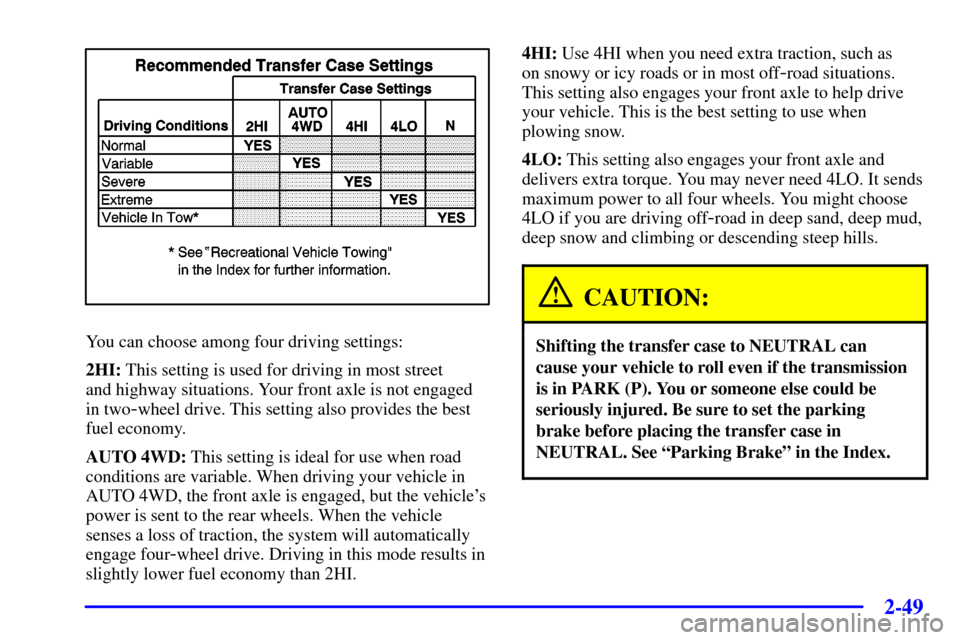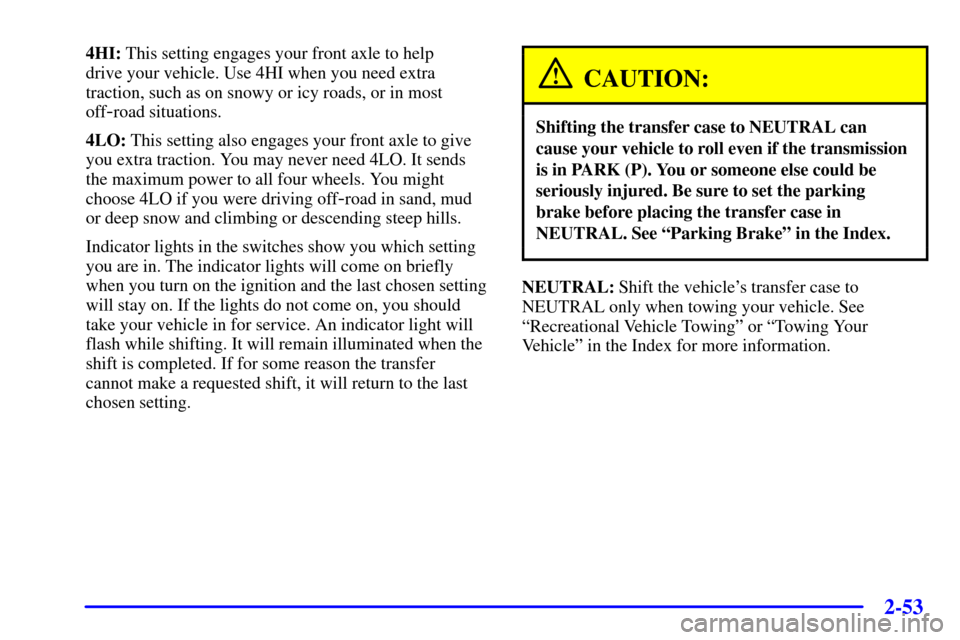Page 127 of 497

2-47
An indicator on the bezel near the lever shows you the
transfer case settings:
2
-Wheel High (2HI): This setting is used for driving in
most street and highway situations. Your front axle is
not engaged in two
-wheel drive. This setting also
provides the best fuel economy.
4
-Wheel High (4HI): Use 4HI when you need extra
traction, such as on snowy or icy roads or in most
off
-road situations. This setting also engages your front
axle to help drive your vehicle. This is the best setting to
use when plowing snow.
CAUTION:
Shifting the transfer case to NEUTRAL can
cause your vehicle to roll even if the transmission
is in PARK (P), or if you have a manual
transmission, even if you are in gear. You or
someone else could be seriously injured. Be sure
to set the parking brake before placing the
transfer case in NEUTRAL. See ªParking Brakeº
in the Index.
NEUTRAL (N): Shift to this setting only when your
vehicle needs to be towed. The ignition switch must be
in RUN in order to shift the lever into NEUTRAL (N).
See ªRecreational Vehicle Towingº or ªTowing your
Vehicleº in the Index.
4
-Wheel Low (4L0): This setting also engages your
front axle and delivers extra torque. You may never need
4LO. It sends maximum power to all four wheels. You
might choose 4LO if you are driving off
-road in deep
sand, deep mud, deep snow and climbing or descending
steep hills.
You can shift from 2
-Wheel High (2HI) to 4-Wheel
High (4HI) or from 4
-Wheel High (4HI) to 2-Wheel
High (2HI) while the vehicle is moving. Your front axle
will engage faster if you take your foot off of the
accelerator for a couple of seconds after you shift. In
extremely cold weather, it may be necessary to stop or
slow the vehicle to shift into 4
-Wheel High (4HI).
Page 128 of 497
2-48
To shift into or out of 4-Wheel Low (4LO)
or NEUTRAL (N):
1. Slow the vehicle to a roll, about 1 to 3 mph
(2 to 5 km/h) and shift an automatic transmission
into NEUTRAL (N), or with a manual transmission,
press the clutch pedal.
2. Shift the transfer case shift lever in one
continuous motion.
Don't pause in NEUTRAL (N) as you shift the
transfer case into 4
-Wheel Low (4LO), or your
gears could clash.
Remember that driving in 4
-Wheel High (4HI) or
4
-Wheel Low (4LO) may reduce fuel economy. Also,
driving in four
-wheel drive on dry pavement could
cause your tires to wear faster and make your transfer
case harder to shift and run noisier.
Automatic Transfer Case (If Equipped)
The transfer case buttons
are located to the left of the
instrument panel cluster.
Use these switches to shift into and out of
four
-wheel drive.
Page 129 of 497

2-49
You can choose among four driving settings:
2HI: This setting is used for driving in most street
and highway situations. Your front axle is not engaged
in two
-wheel drive. This setting also provides the best
fuel economy.
AUTO 4WD: This setting is ideal for use when road
conditions are variable. When driving your vehicle in
AUTO 4WD, the front axle is engaged, but the vehicle's
power is sent to the rear wheels. When the vehicle
senses a loss of traction, the system will automatically
engage four
-wheel drive. Driving in this mode results in
slightly lower fuel economy than 2HI.4HI: Use 4HI when you need extra traction, such as
on snowy or icy roads or in most off
-road situations.
This setting also engages your front axle to help drive
your vehicle. This is the best setting to use when
plowing snow.
4LO: This setting also engages your front axle and
delivers extra torque. You may never need 4LO. It sends
maximum power to all four wheels. You might choose
4LO if you are driving off
-road in deep sand, deep mud,
deep snow and climbing or descending steep hills.
CAUTION:
Shifting the transfer case to NEUTRAL can
cause your vehicle to roll even if the transmission
is in PARK (P). You or someone else could be
seriously injured. Be sure to set the parking
brake before placing the transfer case in
NEUTRAL. See ªParking Brakeº in the Index.
Page 132 of 497
2-52
Shifting Out of NEUTRAL
To shift out of NEUTRAL:
1. Set the parking brake and apply the regular
brake pedal.
2. Shift the transmission to NEUTRAL (N) and turn the
ignition to RUN with the engine off.
3. Press the button for the desired transfer case shift
position (2HI, 4HI, AUTO 4WD or 4LO).
4. After the transfer case has shifted out of NEUTRAL
the red light will go out.
5. You may start the engine and shift the transmission
to the desired position.Electronic Transfer Case (If Equipped)
If your four-wheel-drive vehicle has the electronic
transfer case, the transfer case switches are located to
the left of the instrument panel cluster.
Use these switches to shift into and out of four
-wheel
drive. You can choose among three driving settings:
2HI: This setting is for driving in most street and
highway situations. Your front axle is not engaged in
two
-wheel drive.
Page 133 of 497

2-53
4HI: This setting engages your front axle to help
drive your vehicle. Use 4HI when you need extra
traction, such as on snowy or icy roads, or in most
off
-road situations.
4LO: This setting also engages your front axle to give
you extra traction. You may never need 4LO. It sends
the maximum power to all four wheels. You might
choose 4LO if you were driving off
-road in sand, mud
or deep snow and climbing or descending steep hills.
Indicator lights in the switches show you which setting
you are in. The indicator lights will come on briefly
when you turn on the ignition and the last chosen setting
will stay on. If the lights do not come on, you should
take your vehicle in for service. An indicator light will
flash while shifting. It will remain illuminated when the
shift is completed. If for some reason the transfer
cannot make a requested shift, it will return to the last
chosen setting.
CAUTION:
Shifting the transfer case to NEUTRAL can
cause your vehicle to roll even if the transmission
is in PARK (P). You or someone else could be
seriously injured. Be sure to set the parking
brake before placing the transfer case in
NEUTRAL. See ªParking Brakeº in the Index.
NEUTRAL: Shift the vehicle's transfer case to
NEUTRAL only when towing your vehicle. See
ªRecreational Vehicle Towingº or ªTowing Your
Vehicleº in the Index for more information.
Page 193 of 497
2-113
Cruise Light (If Equipped)
United States Canada
The CRUISE light comes on whenever you set your
cruise control. See ªCruise Controlº in the Index.
4WD Light (If Equipped)
The 4WD indicator will
light up when you shift a
manual transfer case into
four
-wheel drive and the
front axle engages.
Some delay between shifting and the indicator's lighting
is normal.
See ªFour
-Wheel Driveº in the Index for
more information.
Tow/Haul Light
(Automatic Transmissions Only)
This message is displayed
when the tow/haul mode
has been activated.
For more information see, ªTow/Haul Modeº in
the Index.
Page 229 of 497
4-
4-1
Section 4 Your Driving and the Road
Here you'll find information about driving on different kinds of roads and in varying weather conditions.
We've also included many other useful tips on driving.
4
-2 Defensive Driving
4
-3 Drunken Driving
4
-6 Control of a Vehicle
4
-6 Braking
4
-9 Traction Assist System (TAS) (Option)
4
-12 Steering
4
-14 Off-Road Recovery
4
-14 Passing
4
-16 Loss of Control
4
-17 Off-Road Driving with Your
Four
-Wheel-Drive Vehicle
4
-34 Driving at Night4
-35 Driving in Rain and on Wet Roads
4
-38 City Driving
4
-39 Freeway Driving
4
-40 Before Leaving on a Long Trip
4
-41 Highway Hypnosis
4
-42 Hill and Mountain Roads
4
-44 Winter Driving
4
-48 Recreational Vehicle Towing
4
-52 Loading Your Vehicle
4
-62 Camper Wiring Harness (If Equipped)
4
-62 Pickup Conversion to Chassis Cab
4
-63 Towing a Trailer
Page 245 of 497

4-17
Off-Road Driving with Your
Four
-Wheel-Drive Vehicle
This off-road guide is for vehicles that have
four
-wheel drive.
Also, see ªAnti
-Lock Brakesº in the Index.
If your vehicle doesn't have four
-wheel drive, you
shouldn't drive off
-road unless you're on a level,
solid surface.
Off
-road driving can be great fun. But it does have
some definite hazards. The greatest of these is the
terrain itself.
ªOff
-roadingº means you've left the great North
American road system behind. Traffic lanes aren't
marked. Curves aren't banked. There are no road signs.
Surfaces can be slippery, rough, uphill or downhill.
In short, you've gone right back to nature.
Off
-road driving involves some new skills. And that's
why it's very important that you read this guide. You'll
find many driving tips and suggestions. These will help
make your off
-road driving safer and more enjoyable.If you think you will need some more ground clearance
at the front of your vehicle, you can easily remove the
front bumper lower air dam.
The front bumper lower air dam is held in place by a
series of push pins located around the lower edge of the
front bumper. The push
-pins are accessible from
underneath the front bumper.